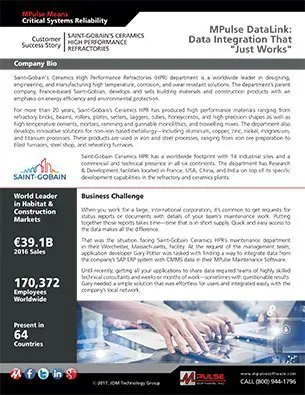Saint-Gobain‘s Ceramics High Performance Refractories (HPR) department is a worldwide leader in designing, engineering, and manufacturing high temperature, corrosion, and wear resistant solutions. The department’s parent company, France-based Saint-Gobian, develops and sells building materials and construction products with an emphasis on energy efficiency and environmental protection.
For more than 20 years, Saint-Gobain’s Ceramics HPR has produced high performance materials ranging from refractory bricks, beams, rollers, plates, setters, saggers, tubes, honeycombs, and high precision shapes as well as high temperature cements, mortars, ramming and gunnable monolithics, and trowelling mixes. The department also develops innovative solutions for non-iron based metallurgy—including aluminum, copper, zinc, nickel, magnesium, and titanium processes. These products are used in iron and steel processes, ranging from iron ore preparation to blast furnaces, steel shop, and reheating furnaces.
Saint-Gobain Ceramics HPR has a worldwide footprint with 14 industrial sites and a commercial and technical presence in all six continents. The department has Research & Development facilities located in France, USA, China, and India on top of its specific development capabilities in the refractory and ceramics plants.
Solution
Since 2014, Saint-Gobain Ceramics HPR has used MPulse Platinum—our most comprehensive software package designed for the largest, most complex maintenance operations. MPulse Platinum includes all the core features and functions offered in our entire product line. Saint-Gobain Ceramics HPR also uses several MPulse feature extension modules.
The department’s maintenance team of 16 people uses MPulse for a wide range of maintenance tasks—from managing PMs, work orders, and service requests, to tracking and controlling inventory and managing vendors. Sophisticated features, like asset-level financial tracking, make this package a professional-grade tool for experienced maintenance teams like Saint-Gobain.
Gary worked closely with MPulse during the initial implementation process, and he turned to MPulse again for a data integration solution. Working with our support team, he quickly determined the MPulse DataLink Integration Adapter was the way to go.
DataLink offered Gary a way to easily move data in and out of MPulse using a familiar, intuitive interface. Now when maintenance technicians create a purchase requisition, the company’s SAP ERP software associates the purchase order with the specific work order. When the parts are received, SAP sends the costs and stock information to MPulse, giving managers access to the numbers they need to make important decisions. As a result, the maintenance crew and the accounting department are in sync and their inventory stock levels are updated and accurate.
Best of all, “it’s all automatic,” Gary explained. “MPulse DataLink checks for new information every few minutes. We don’t have to do anything else.”
Benefits of Turn-Key Data Integration
DataLink enables Saint-Gobain to leave the accounting to the financial application, and synchronize the results back to MPulse for informational and reporting purposes. As a result, Saint-Gobain maintenance managers can use financial data and CMMS data to accurately calculate maintenance costs.
After an easy implementation process, Saint-Gobain plans to expand the use of DataLink by using MPulse’s advanced inventory capabilities in the future. The company anticipates big benefits, like the ability to…
- Accelerate and track the complete purchase lifecycle
- Leverage MPulse’s reporting and forecasting capabilities to drive business intelligence
- Eliminate manual double entry of inventory and purchasing information
- Increase accuracy and freshness of data
- Reduce emergency non-stock situations by improving usage planning
- Implement standardized data and improve vendor management
While all of those benefits are important, Gary emphasized another one that is close to any IT professional’s heart: “It just works.”








